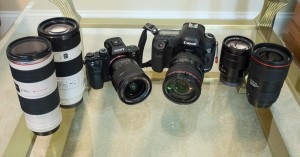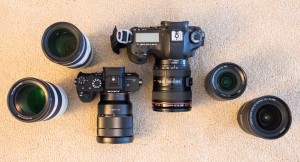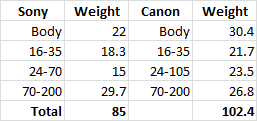Move from Canon to Sony after 10 years…
I’ve finally decided to give my back a rest and move to a slightly smaller camera kit, hopefully without sacrificing quality along the way! As a result, all my Canon stuff will be going and making room for a new Sony A7R ii body plus 16-35mm F4, 24-70mm F4 and 70-200mm F4 Sony lenses. I decided to go this way rather than buy a lens adapter and use my Canon lenses partly for convenience and weight and partly because those Canon lenses still have a reasonable resale value and I thought it was better to completely make the break. My normal camera bag carries those equivalent Canon lenses, a 50mm F1.4, and a 1.4x extender for the zoom. I don’t tend to use the 50mm very much, although I might look for an equivalent one for the Sony in due course, and my thought was that a crop into a 42M pixel frame was roughly equivalent to the extender. I separately have the Canon 100mm F2.8 macro and extension tubes that will need to be replaced at some point as well.
The biggest difference between the kits is the size of the body:
The two wider lenses are also a fair bit smaller than their Canon equivalents (all lenses are F4), but the 70-200mm lenses are pretty similar in size and weight:
The weight was one of the factors behind this, so here is a small table comparing the systems:
So the new kit is about 17 ounces lighter (ie the Canon kit is 20% heavier) – not a lot, bearing in mind the differences in size, but I guess glass in the lenses weighs the same regardless of manufacturer. The other point of note at this stage is that the filters are 72mm on the Sony wide angle and telephoto zooms and 67mm on the 24-70mm, compared to 77mm on two of the Canon lenses and 67mm on the 70-200mm F4 lens. So I will be carrying step down filter adapters. I don’t tend to have a filter permanently on the lenses, preferring to add them when needed, and the wider filter (especially my variable ND filter) will be less likely to vignette on the wider angle lenses. However, I won’t be able to use the lens hood when the filters are in place, although that isn’t a great issue most of the time.
The other thing that I thought about was my flashes – I have 4 Canon flash guns (3x 550 and 1x 580) plus the ST-E2 controller. I use them mainly in manual mode in a studio setting and so the loss of automatic exposure isn’t an issue. I did find an article by Tim Ford where he comprehensively tested the Canon 580 and ST-E2 on a Sony A7R and found that they worked fine in manual mode with a sync speed of 1/250 second using a flash as the master mounted on the camera, but the sync speed dropped to 1/80 second using the ST-E2. That second result isn’t great, but for most stock work the object is still anyway and my camera would be on a tripod, so I can live with that.
The final bit I considered was the tripod connection itself. I have a plate fixed on my Canon, but I found lots of great praise for the custom designed L-plate from Really Right Stuff. I haven’t fitted it yet, but it seems very well made (as it should for $175!!)
More on how I configured the camera later, and then I’ll get onto some real usage comments – first my preferred camera settings and then some actual results.










Long time reader, first time poster.
I think a lot of us are also on the fence about this switch but the battery life and cost have prevented me, personally, from doing so. Also, I’m anticipating what Canon will do with their 6D mark 2 but it seems like Sony will soon eat Canon’s lunch if Canon doesn’t get their act together. I’d love to hear your further opinions about the A7 as you settle into the new gear!
Is it safe to assume the Sony gear costs significantly more than the Canon gear?
Please keep us updated and have fun with your new toys!
The pricing is pretty similar to the 5D Mk III and L series lenses. I’m still working on setting them up so that will be the next blog post!
As Pius says a lot of us are on the fence at the moment with cost being a big factor. Nevertheless, a switch is on the cards for most of us I believe. I delved tentatively into the mirrorless market with the EOS M despite all its well documented faults. I bought it at a giveaway price – equivalent of 450 USD which included 2 lenses, flash and lens adaptor. As it has the same sensor as my Canon 60D I am impressed by the quality of the images but recognise that it is no substitute. I guess I am really hoping for a Canon breakthrough in this area in order that I can keep my existing lenses to lessen the cost of a switch. Cost of the Sony for me is a little prohibitive but it is a very attractive proposition nevertheless. Look forward to hearing your experiences.
regards
Hi Kevin
I’ll report on the final cost once I have sold my Canon stuff – the real cost is obviously the new Sony minus the cash obtained from selling the Canon lenses and body.
Steve